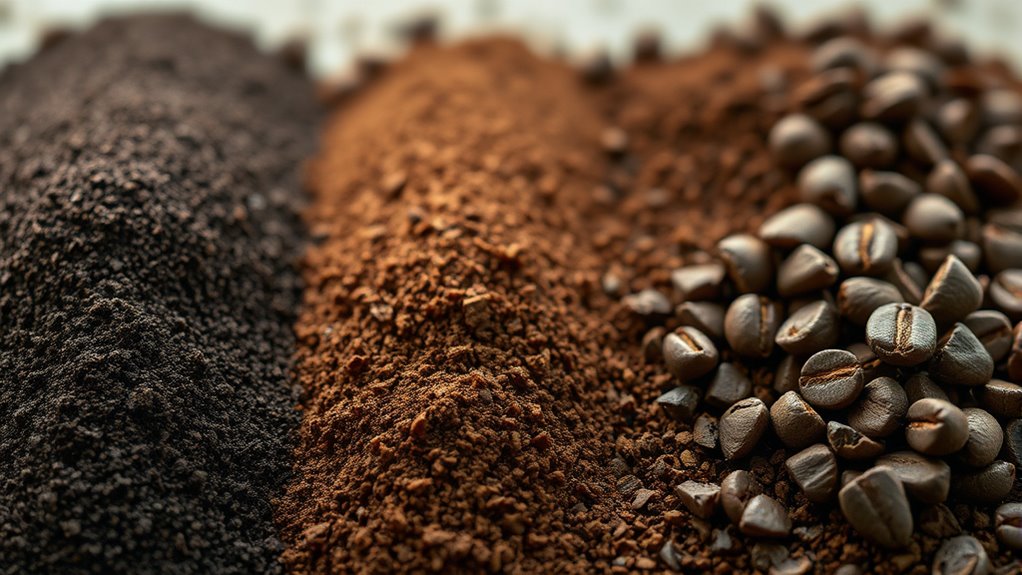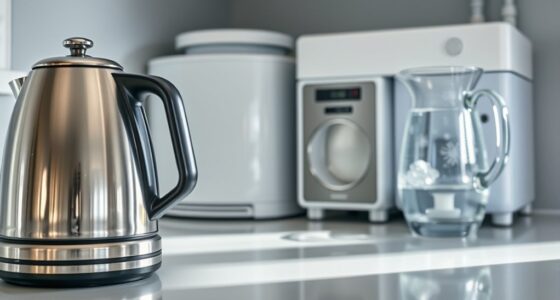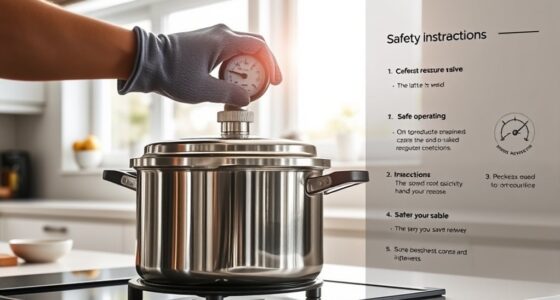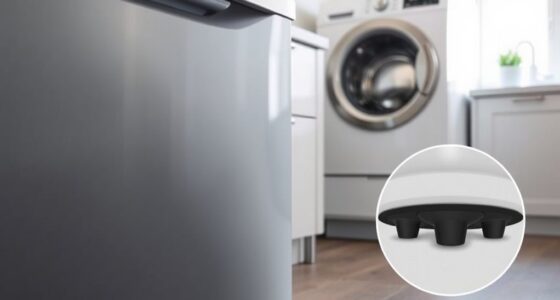Choosing the right coffee grind size is key to unlocking the best flavor for your brew. If you want a rich espresso, go for a fine grind; for French press or cold brew, use a coarse grind. Consistent grind size ensures even extraction, preventing bitterness or weak taste. Burr grinders help achieve uniform particles perfect for each method. Keep experimenting with adjustments, and you’ll master every cup. Want to learn how to perfect your grind for any brewing style?
Key Takeaways
- Match grind size to your brewing method: fine for espresso, medium for drip, coarse for French press.
- Use a burr grinder for consistent particle size, ensuring proper extraction and optimal flavor.
- Adjust grind size gradually to prevent over- or under-extraction, tailoring it to your specific brew.
- Consistent grind size improves flavor clarity and helps replicate successful coffee results every time.
- Experiment with grind settings to find the perfect match for your preferred brewing method and taste profile.

Have you ever wondered how the size of your coffee grind influences the flavor and strength of your brew? The answer lies in the tools you use and the consistency of the grind itself. Burr grinders are often the top choice for coffee enthusiasts because they produce a uniform grind size, guaranteeing each particle is similar in shape and size. This grind consistency is vital because it directly impacts how water interacts with the coffee grounds during brewing. When your grind is uneven, some particles extract faster than others, leading to a brew that’s over-extracted and bitter or under-extracted and weak. Burr grinders allow you to adjust the grind size precisely and maintain that setting, giving you control over the extraction process and, ultimately, the flavor profile.
Consistent grind size with burr grinders ensures balanced, flavorful coffee every time.
The key benefit of using burr grinders is their ability to deliver grind consistency. Unlike blade grinders, which chop beans randomly and often produce uneven particles, burr grinders crush beans between two revolving burrs. This method results in a uniform grind, making it easier to match the grind size to your preferred brewing method. For example, a fine grind is ideal for espresso, while a coarser grind works better for French press or cold brew. When you use a burr grinder, you can tweak the settings to get the perfect size for each brewing method, guaranteeing ideal extraction every time. This consistency means your coffee will taste balanced, with neither under- nor over-extraction dominating the flavor.
Choosing the right grind size is vital because different brewing methods require different particle sizes to achieve the best results. A too-fine grind for a French press, for instance, can lead to over-extraction, making your coffee bitter and overly strong. Conversely, a too-coarse grind for espresso might result in a weak, under-extracted shot. Burr grinders give you the precision needed to match the grind to each method, helping you avoid these common pitfalls. When you invest in a burr grinder and focus on grind consistency, you gain more control over flavor, strength, and overall coffee quality. It’s a simple step that makes a significant difference in how your coffee tastes, allowing you to brew with confidence every single time.
Furthermore, grind size consistency is especially crucial for specialty coffee brewing, where subtle flavor nuances are more apparent. In the end, understanding how grind size and consistency influence your coffee’s flavor helps you become a better barista at home. By choosing a burr grinder and paying attention to grind size adjustments, you guarantee each cup is tailored to your preferences and brewing style. It’s all about fine-tuning your process for the perfect cup, whether you’re brewing a shot of espresso or a leisurely French press. The more you experiment with grind size and consistency, the more you’ll learn to craft coffee that’s just right for you.
Frequently Asked Questions
How Does Grind Size Affect Coffee Extraction Time?
Grind size directly impacts your coffee’s extraction time, affecting brew strength and flavor clarity. A finer grind speeds up extraction, making your coffee stronger and more intense, while a coarser grind slows it down, resulting in a milder taste. Adjusting grind size helps you control the balance between brew strength and flavor clarity, ensuring you get the perfect cup every time. So, choose your grind size based on your preferred brew method.
Can Changing Grind Size Improve Under-Extracted Coffee?
Yes, changing your grind size can improve under-extracted coffee. By ensuring grind size consistency, you promote even extraction, which enhances flavor profile. If your coffee’s under-extracted, try using a slightly coarser grind for methods like French press or a finer grind for espresso. This adjustment helps water interact more evenly with the coffee grounds, revealing richer flavors and delivering a more balanced, satisfying cup every time.
What Is the Ideal Grind Size for Cold Brew?
Your ideal grind size for cold brew is coarse, like sea salt. This size guarantees ideal extraction, preventing over-brewed bitterness or under-extraction. To get the best flavor, use fresh coffee beans and maintain grind size consistency. If your grind is too fine, your cold brew might turn out too bitter or cloudy. Keep it coarse, fresh, and consistent for smooth, rich cold brew every time.
How Often Should I Adjust My Grind Size?
You should adjust your grind size whenever you notice changes in your coffee’s flavor or extraction, typically every few weeks. Keep an eye on grind consistency to guarantee uniformity, and recalibrate your equipment regularly. Small tweaks can make a big difference, so don’t hesitate to experiment until your brew hits the perfect balance. Regular adjustments help maintain ideal flavor and prevent over or under-extraction.
Does Altitude Influence Optimal Grind Size for Brewing?
Yes, altitude impact affects your grind size because higher elevations often mean beans have higher density, which can alter extraction. You might need a slightly coarser grind at higher altitudes to prevent over-extraction, while lower altitudes might require a finer grind. Pay attention to how your brew tastes and adjust accordingly, considering the bean density influenced by altitude. Experimenting ensures you optimize flavor regardless of elevation.
Conclusion
Now that you’ve revealed the secrets of grind size, think of your coffee as a symphony, each note perfectly tuned to the brew method. When you match the grind to your method, you’re painting a masterpiece with every cup—rich, balanced, and full of life. So, embrace your newfound knowledge like a skilled artist wielding a brush, and watch your mornings transform into a vibrant canvas of aroma and flavor. Your perfect brew awaits—just grind and enjoy.









